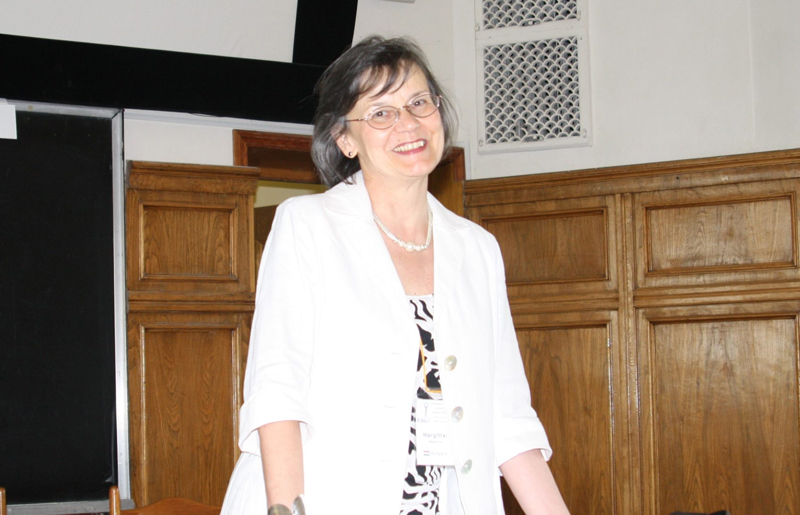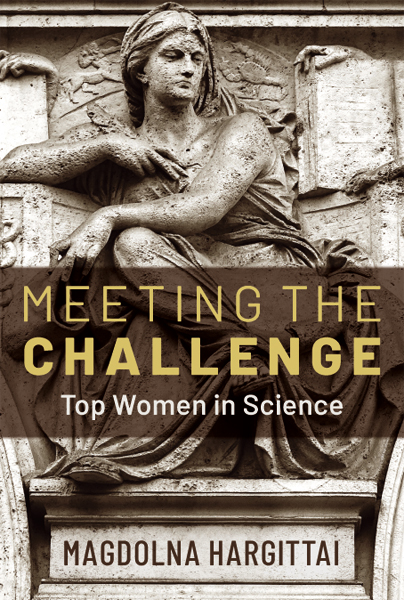Telling the stories of women scientists: An interview with Magdolna Hargittai MAE#
Magdolna Hargittai discusses her latest book which focuses on the achievements of female scientists and the importance of role models in promoting and supporting more women in STEM.

Professor Magdolna Hargittai
About Magdolna Hargittai MAE#
Professor Magdolna Hargittai MAE is Research Professor at the Budapest University of Technology and Economics . She was elected to the Hungarian Academy of Sciences
. She was elected to the Hungarian Academy of Sciences in 2004 and to the Academia Europaea in 2006. She has published broadly on women in science, telling the stories of women scientists throughout history and from all over the world to inspire and provide role models for individuals interested in pursuing scientific careers. She has recently published Meeting the challenge: Top women in science (Oxford University Press, 2023).
in 2004 and to the Academia Europaea in 2006. She has published broadly on women in science, telling the stories of women scientists throughout history and from all over the world to inspire and provide role models for individuals interested in pursuing scientific careers. She has recently published Meeting the challenge: Top women in science (Oxford University Press, 2023).
The interview#
Congratulations on the publication of your most recent book in which you once again shine a spotlight on the achievements of female scientists. Why is this so important to you?
“Thank you. After my first book about women scientists, I felt that I would like to reach a larger circle of readers by expanding the coverage and trying to make the discoveries I describe a little easier to comprehend. Once again, I greatly enjoyed working on this book and found it fulfilling as well.”
You’ve written a number of books on women in science. While researching your book Women scientists, you asked famous women scientists to name the greatest challenge in their life. You said “Almost without exception, they noted the difficulty of adjusting their family obligations and their work”. Is this changing?
“It is changing very slowly, but this difficulty will never disappear entirely. The recognition of it is already an important step in the right direction. Of course, the problem always existed, but recognising it meant acknowledgement of the need to do something about it. Making working hours flexible, giving researchers extra years to apply for awards and positions with upper age limits, offering day care for small children, these are but a few random examples of how women scientists can be helped, especially in the early years of their careers.”
Are there other recurring themes that stand out in your books?
“You just named the most important one with your previous question. Another was, but not so pervasive, the disadvantaged situation of women when it comes to career promotion. This seems to be easier to eliminate and, once again, shining a light on it has helped to ease the situation. Another problem which is not featured so much in the book is elections to national academies, nominations for prizes and awards. It appears that the institution offering the most prestigious recognition, the Nobel Prize, has made great strides recently in the right direction.”
What have you learnt about obtaining professional success and personal happiness?
“Perhaps that professional success and personal happiness are not mutually exclusive. It is also true that the two may have different relative weights in the value system for each individual. Furthermore, I have learned to try to go below the surface if I want to understand a person’s true aspirations (which is, of course, applicable to men as well). I often remember a conversation with a very successful Japanese scientist. I asked her if a miracle could fulfil her single most important desire, what would it be? She hesitated before answering, wanting to first double-check whether she could name any desire, however outrageous it might be. When I said yes, she said her dream would have been to have a family, in addition to her professional success. I find it difficult to communicate in these simple words the emotional charge this exchange carried.”
Were there any individual stories in your latest book which have particularly inspired you?
“I wouldn’t single out any individual, but rather give a generic example – the woman scientist who, in addition to being a woman in the largely men’s world of science, has had to overcome additional difficulties, such as being Black or being Jewish, surviving a family tragedy, being disabled by a devastating illness or challenged in any other way, such as living under a dictatorship, coming from a very poor family, going to a disadvantaged school, and so on, and yet having had the determination and stamina to struggle her way through to acquiring the education and knowledge she craved and fulfilling her dream of becoming a scientist and contributing creatively to science.”
As part of the CALIPER project, Academia Europaea Cardiff has created a set of videos about inspirational women who work in STEM, with the aim of generating debate about gender (in)equality. What more can be done to promote and support more women in STEM?
“I find this approach to be exceptionally important and effective. Project role models show interested high school students and budding scientists alike that it is possible to succeed. Many of the current famous women scientists tell the story of how inspiring it was when they saw a film or read a book about Madame Curie. Today, we should be showing more of such examples and not only about world-famous women scientists but also about everyday heroes. Look at the deeds of the biochemist Katalin Karikó or the materials scientist Agnes Csanády, to give two living examples. Karikó left Hungary, whereas Csanády spent her entire career in Hungary. Karikó contributed in a major way to the vaccine against Covid-19, thereby saving countless lives. Csanády prepared the world’s most beautiful quasicrystals, soon after their original discovery (by the future Nobel laureate Dan Shechtman), at a time when their existence was being questioned by the greatest living chemist. They are both inspirational examples, still living amongst us.”
The interview was conducted by the
Academy Cardiff Knowledge Hub
.
You may also be interested in this item#
As part of the CALIPER project, the Cardiff Knowledge Hub is conducting a series of interviews with inspirational women who work in STEM research and innovation. The interviews explore what motivated them to choose their career, their experiences and the barriers that they faced. Take a look at the role model interviews
project, the Cardiff Knowledge Hub is conducting a series of interviews with inspirational women who work in STEM research and innovation. The interviews explore what motivated them to choose their career, their experiences and the barriers that they faced. Take a look at the role model interviews .
.
 . She was elected to the Hungarian Academy of Sciences
. She was elected to the Hungarian Academy of Sciences in 2004 and to the Academia Europaea in 2006. She has published broadly on women in science, telling the stories of women scientists throughout history and from all over the world to inspire and provide role models for individuals interested in pursuing scientific careers. She has recently published Meeting the challenge: Top women in science (Oxford University Press, 2023).
in 2004 and to the Academia Europaea in 2006. She has published broadly on women in science, telling the stories of women scientists throughout history and from all over the world to inspire and provide role models for individuals interested in pursuing scientific careers. She has recently published Meeting the challenge: Top women in science (Oxford University Press, 2023).
 .
.
 project, the Cardiff Knowledge Hub is conducting a series of interviews with inspirational women who work in STEM research and innovation. The interviews explore what motivated them to choose their career, their experiences and the barriers that they faced. Take a look at the role model interviews
project, the Cardiff Knowledge Hub is conducting a series of interviews with inspirational women who work in STEM research and innovation. The interviews explore what motivated them to choose their career, their experiences and the barriers that they faced. Take a look at the role model interviews .
.



